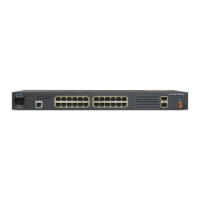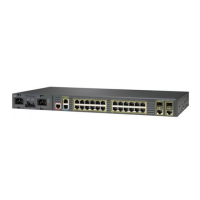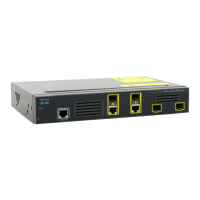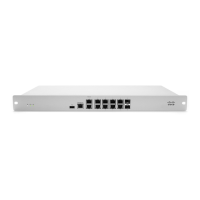26-16
Cisco ME 3400 Ethernet Access Switch Software Configuration Guide
OL-9639-07
Chapter 26 Configuring SPAN and RSPAN
Configuring SPAN and RSPAN
• For RSPAN configuration, you can distribute the source ports and the destination ports across
multiple switches in your network.
• RSPAN does not support BPDU packet monitoring or other Layer 2 switch protocols.
• The RSPAN VLAN is configured only on trunk ports and not on access ports. To avoid unwanted
traffic in RSPAN VLANs, make sure that the VLAN remote-span feature is supported in all the
participating switches.
• Access ports on the RSPAN VLAN are put in the inactive state.
• RSPAN VLANs are included as sources for port-based RSPAN sessions when source trunk ports
have active RSPAN VLANs. RSPAN VLANs can also be sources in SPAN sessions. However, since
the switch does not monitor spanned traffic, it does not support egress spanning of packets on any
RSPAN VLAN identified as the destination of an RSPAN source session on the switch.
• You can configure any VLAN as an RSPAN VLAN as long as these conditions are met:
–
The same RSPAN VLAN is used for an RSPAN session in all the switches.
–
All participating switches support RSPAN.
–
MAC address learning is not disabled on the RSPAN VLAN.
• We recommend that you configure an RSPAN VLAN before you configure an RSPAN source or a
destination session.
Configuring a VLAN as an RSPAN VLAN
Create a new VLAN to be the RSPAN VLAN for the RSPAN session. You must create the RSPAN VLAN
in all switches that will participate in RSPAN. You must configure RSPAN VLAN on source and
destination switches and any intermediate switches.
To get an efficient flow of RSPAN traffic, manually delete the RSPAN VLAN from all trunks that do not
need to carry the RSPAN traffic.
Beginning in privileged EXEC mode, follow these steps to create an RSPAN VLAN:
To remove the remote SPAN characteristic from a VLAN and convert it back to a UNI-ENI isolated
VLAN, use the no remote-span VLAN configuration command.
Command Purpose
Step 1
configure terminal Enter global configuration mode.
Step 2
vlan vlan-id Enter a VLAN ID to create a VLAN, or enter the VLAN ID of an
existing VLAN, and enter VLAN configuration mode. The range is
2 to 1001 and 1006 to 4094.
Note The RSPAN VLAN cannot be VLAN 1 (the default VLAN)
or VLAN IDs 1002 through 1005 (reserved for Token Ring
and FDDI VLANs).
If you enter the VLAN ID of a UNI-ENI community VLAN,
you must remove the community VLAN type by entering the
no uni-vlan VLAN configuration command.
Step 3
remote-span Configure the VLAN as an RSPAN VLAN.
Step 4
end Return to privileged EXEC mode.
Step 5
copy running-config startup-config (Optional) Save the configuration in the configuration file.

